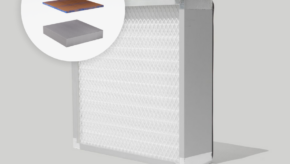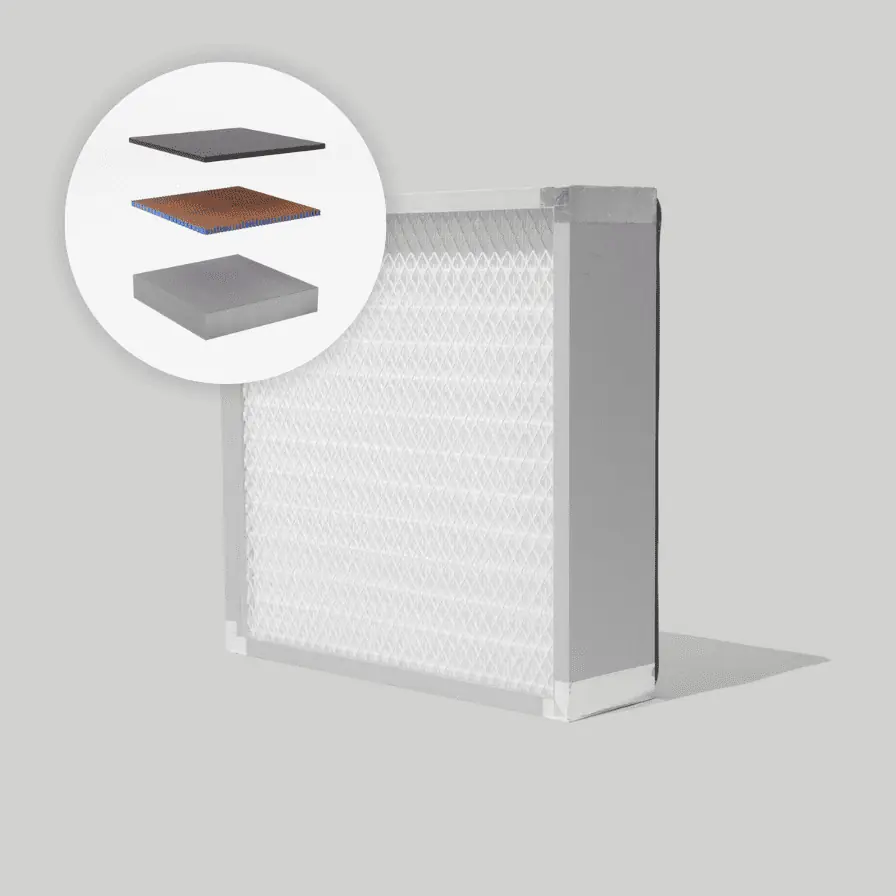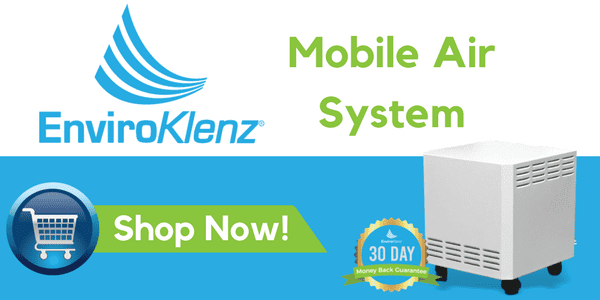What Are SVOC’s?
 The indoor air in most homes today contain a wide variety of pollutants that can affect your health. Particulate pollutants—such as dust, pollen, and animal dander—are well known for causing typical allergy symptoms of coughing, sneezing, runny nose, and itchy watery eyes.
The indoor air in most homes today contain a wide variety of pollutants that can affect your health. Particulate pollutants—such as dust, pollen, and animal dander—are well known for causing typical allergy symptoms of coughing, sneezing, runny nose, and itchy watery eyes.
Living micro-organisms—including mold, bacteria, and viruses—are also widely known. Bacteria and viruses spread contagious diseases such as flu and chicken pox, and mold in a home can cause health problems that go way beyond allergy symptoms to cause fatigue, headaches, poor memory, and more.
VOCs (Volatile Organic Chemicals) have become more widely known in the past few decades, as the field of indoor air pollution has established the presence of these toxic chemical gasses in modern homes and buildings. Chronic exposures over time lead to irritation of the eye, nose, and throat, headaches, nausea, dizziness, and can effect entire body systems, including the nervous system and endocrine system.
SVOCs are a specific type of VOC that acts in a certain way and causes it’s own set of symptoms. While VOCs levels are now commonly disclosed on product labels, SVOCs are are still almost unknown to the general public. To even begin to understand SVOCs and their behavior, we first need to understand about particles and gasses.
PARTICLES
Particles are microscopic bits of pollen, dust, fibers, animal dander and other solid matter. These are so small they are measured in microns (1 micron is about 25,000th of an inch). The period at the end of a sentence is 615 microns.
Unlike large particles that settle on surfaces as “dust,” these very small particles (smaller than 10 microns) can remain airborne in your home for long periods of time.
 A gas is a different type of matter. It is a substance that has the property of indefinite expansion, rather than being limited to a liquid or solid. Gasses are like air and have no fixed shape, but they can be trapped and also attach to particles, as we shall see.
A gas is a different type of matter. It is a substance that has the property of indefinite expansion, rather than being limited to a liquid or solid. Gasses are like air and have no fixed shape, but they can be trapped and also attach to particles, as we shall see.
Steam is a gas that is easy to see. It is the gaseous form of water. We can observe with our own eyes that steam is made up of tiny droplets of water as it rises from a boiling pot, and we can also see steam dissipate as those tiny droplets move through the air in a room and more and more air comes between them.
All air pollutants that are gasses behave just like steam.
VOCS – VOLATILE ORGANIC COMPOUNDS
There is a whole group of chemicals known as “volatile organic chemicals” (VOCs) because they easily release gases into the air at room temperature. These released gasses are called “emissions” and the process of emissions being released is known as “outgassing.”
Outgassing occurs from solid materials that release gases—such as plastics, paints, and particleboard—and liquids—such as perfume, paint, pesticides, and cleaning chemicals.
VOCs can also come from secondhand tobacco smoke, which is known to include more than 200 different VOCs.
Once released into the air, VOCs float around until someone inhales them, they are ventilated out of the room through an open window or HVAC system, or they are captured by an air filter.
VOCs can be very harmful to health and often have unpleasant odors. Paint fumes are VOCs. “New carpet smell” and “new car smell” are VOCs. Health effects can range from cancer to respiratory problems, and much more.
SVOCs – SEMIVOLATILE ORGANIC COMPOUNDS
Semivolatile organic compounds (SVOCs) are a subgroup of VOCs. Technically they are defined by having a higher molecular weight and higher boiling point than other VOCs, but they also behave differently. In addition, they are more difficult to measure.
The United States Environmental Protection Agency {EPA) lists more than 1000 SVOCs as high-production-volume chemicals (those produced or used at more than 1 million pounds per year).
Because of their slow rate of release from sources and their propensity to be absorbed by solids, SVOC gasses can persist for years indoors— even after the original source is removed. They are considered to be akin to persistent organic pollutants (POPs) in the outdoor environment.
Many of the most common chemicals in the news today are SVOCs. Those present in indoor air include:
• Phthalates – in PVC (shower curtains and other sources), fragrances, building materials
• Perfluorinated chemicals (PFCs) – in food packaging, waterproofed clothing, cookware
• Organochlorine pesticides – resides from past indoor applications
• Brominated fire retardants – furniture, electronics
Manmade SVOCs have been in our indoor environments for less than 100 years and only started being a problem in the 1980s when the energy crisis of the time resulted in tightly sealing buildings for energy-efficiency. But humans have been exposed to some SVOCs—such as polycyclic aromatic hydrocarbons (PAHs)— for millennia. PAHs are by-products of combustion and are released from every fireplace, wood stove, campfire, barbecue, gas flame, and candle.
SVOCs can easily outgas from the surfaces of products containing them because they are not “bound” to the materials.
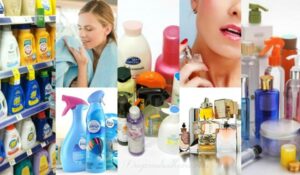 SVOCs enter a home environment as parts of a product—such as paint or perfume—and outgas into the air. They can then float in the air as a gas, or attach to a surface, or attach to surfaces of airborne and settled particles, becoming a component of dust. In this way, SVOCs become ubiquitous in indoor environments, as they are released from multiple sources in the home and adsorb to all indoor surfaces.
SVOCs enter a home environment as parts of a product—such as paint or perfume—and outgas into the air. They can then float in the air as a gas, or attach to a surface, or attach to surfaces of airborne and settled particles, becoming a component of dust. In this way, SVOCs become ubiquitous in indoor environments, as they are released from multiple sources in the home and adsorb to all indoor surfaces.
Every day, then, we are exposed to gaseous SVOCs or SVOCs adsorbed on airborne particles by
• Inhalation of SVOC gasses and particles that have adsorbed SVOCs
• Ingestion of particles that have adsorbed SVOCs from touching coated surfaces
• Absorption of airborne SVOC gasses directly through the skin. Researchers have found human uptake of SVOCs by absorption on the skin can equal or in some cases exceeding intake through inhalation.
Body burden studies have found measurable levels of more than 100 SVOC in the bodies of the US population.
The list of health effects caused by SVOCs is extensive.
Many SVOCs alter the activity of hormones. These are called endocrine disrupting chemicals (EDCs). EDCs contribute to neurodevelopmental and behavioral problems, reproductive abnormalities (such as infertility), metabolic disorders (obesity, diabetes), and cancer. SVOCS considered to be endocrine-disrupting chemicals include brominated flame retardants, phthalates, pesticides, antimicrobials, and polycyclic aromatic hydrocarbons.
Of course, each SVOC has it’s own health effects depending on the nature of the chemical and the degree of exposure. Individual sensitivities also play a part.
Multiple SVOCs, multiple routes of exposures to SVOCs, and the potential persistence of SVOCs make for a complex situation in any indoor environment.
How To Remove VOCs from your Home
The best strategy for reducing exposure to SVOCs is
1. Identify and remove sources of SVOC outgassing
2. Clean surfaces that may have collected SVOC
3. Get an air filter that will remove VOCs
Best Air Purifier For VOCs
The EnviroKlenz-Air technology is a patented, revolutionary, non-invasive, odor restoration process that can rapidly restore an odor-compromised property to a workable and livable environment.When a home or business has an acute chemical or malodor, the EnviroKlenz mobile air system can be immediately deployed in portable air cleaner or HVAC filter to begin restoring the environment utilizing the most environmentally friendly odor restoration process available. It removes the airborne odor-causing molecules without releasing chemicals into the air like hydroxyl, ozone, masking agents or thermal fogging processes.
The unit is portable and once the patented EnviroKlenz-Air® Cartridge (size 14”x14” included with purchase) is installed you will begin to remove and neutralize those unwanted malodors circulating in your home.
+ An easily installed EnviroKlenz-Air Cartridge contains a proprietary blend of materials to neutralize odors, chemicals, gasses, Volatile Organic Compounds (VOCs), and larger particulates.
+ A multi-speed blower offers the quiet and efficient airflow. The low setting allows for near silent operation while still maintaining odor elimination. Medium to High speeds creates maximum air efficiency at noise levels still suitable for residential and commercial use.
+ Affordable maintenance costs.
+ No tools are required for unit maintenance.
Dimensions: 15.5″W x 15″D x 19″H; weighs less than 20 pounds. 115 volts; 60 Hz; 1 amp; 100 watts; 8 foot power cord.
*No HEPA is included with the standard purchase of the mobile system, you may purchase the HEPA filter as an upgrade to the unit with your initial purchase or at future date on our site.
For more information, you may reach us at our contact us page or call us direct at 239-331-5711
Our Recommended Solution…
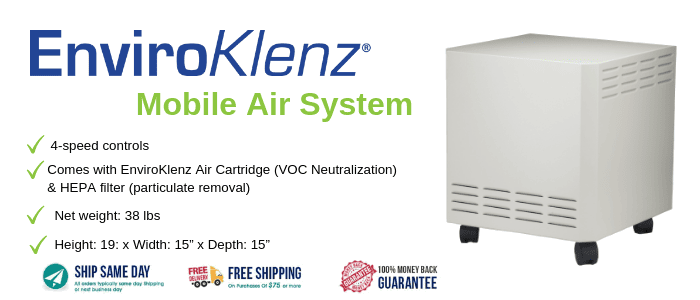
The EnviroKlenz Mobile Air System is your solution to removing VOCs and chemical pollutants from your indoor environment. With the use of a hospital-grade HEPA filter and an effective earth mineral technology air cartridge, this two-stage filtration is perfect to place in your indoor space to mitigate potential hazards to your health. Whether you have chemical sensitivities, allergies, or are just looking to improve your indoor air quality, the EnviroKlenz Mobile Air System is your answer!
- Simple and Easy to Set-Up, with Minimal Maintenance
- Replace Air Cartridge every 4 to 6 Months
- HEPA Filter Replaced Every Two Years
- Quiet Operation, 4-Speed Motor
- No Chemical Odors Released!
We are confident that our EnviroKlenz Technology will drastically reduce the odors in your home, if it doesn’t live up to your expectations, we will issue a full refund within 30 days of your purchase!
Click below to buy NOW!
Hear What People Are Saying About Us…

